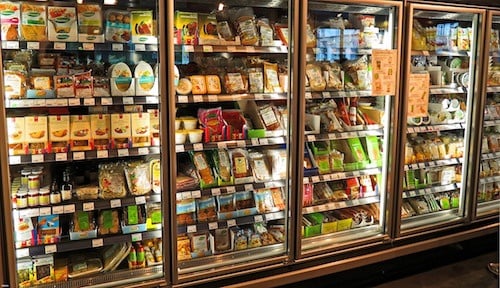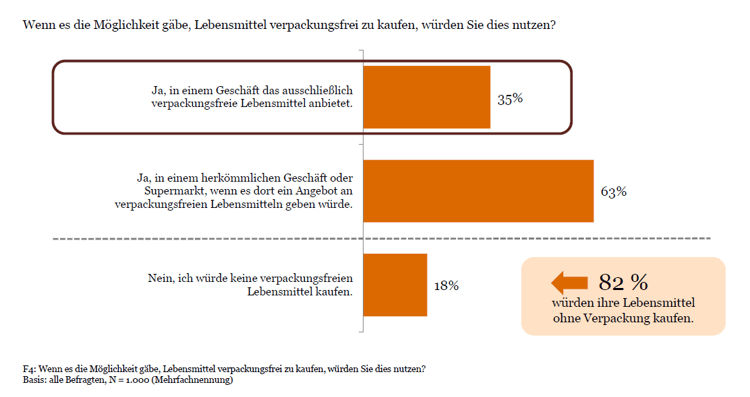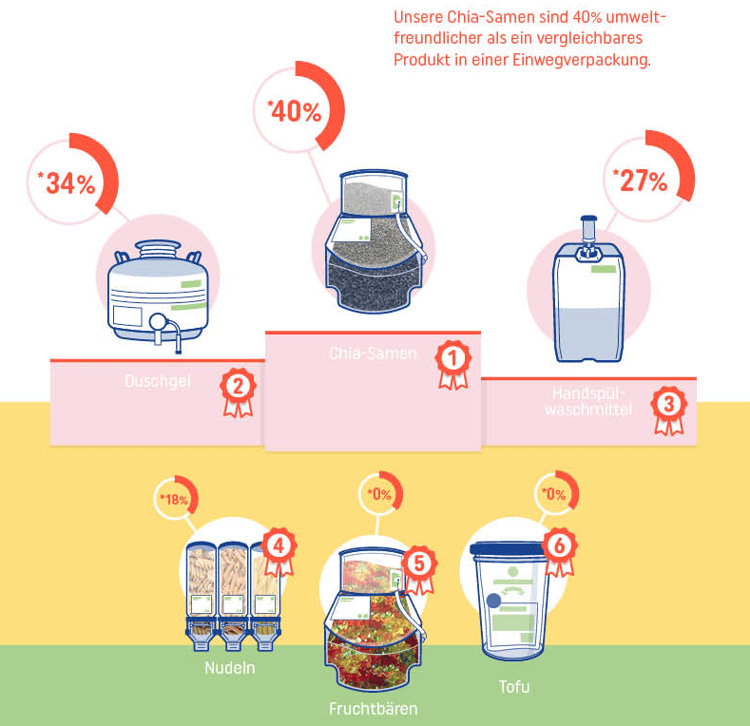The packaging-free supermarket - trend or future?
In the past it was quite normal to buy food without packaging from the Greißler around the corner. Today this is rather the exception. For several years now, more and more shops have been developing that offer only unpackaged products. The packagingless supermarket is in vogue - what opportunities it has and how this trend affects the packaging industry is highlighted in this article.

A brief glimpse into the history of its origins
The pioneer of this trend was the Canadian retail chain Bulk Barn, which opened its first store as early as 1982 and now operates an impressive 250 sales outlets with more than 4,000 products. However, it took 25 years until this idea was also taken up in Europe. In 2007, unpackaged was the first European company to open an unpackaged food store in London.
Since 2014, the trend has also arrived in German-speaking countries. In spring 2014, Lunzers Maß-Greißlerei opened Austria's first packaging-free supermarket in Vienna, and in Berlin the founders of Original Unverpackt created a great media hype with their store. In the meantime, packaging-free supermarkets have established themselves in almost every state capital and even smaller cities in Austria.
How the packaging-free supermarket appeals to consumers
Price, Waterhouse & Co. (PwC) has shed more light on the trend in the study "Packaging-free food - niche or trend? For the representative consumer survey, 1,000 people over 18 years of age were surveyed. As the study shows, the vast majority of survey participants are very positive about the idea - eight out of ten customers would be prepared to do without packaging when buying food:
- 82 percent of consumers are prepared to buy food without packaging.
- 63 percent want a wider range of package-free food in conventional supermarkets.
- 35 percent would prefer a supermarket that offers only package-free food.
- 18 percent cannot imagine foregoing packaging.

graphics
: © PWC, Studie „Verpackungsfreie Lebensmittel – Nische oder Trend?"
Environmental awareness as the main motive
Reducing packaging waste and protecting the environment - this is the decisive argument for packaging-free shopping for 64 percent of the survey participants. In second place, with 54 percent, is the possibility of being able to portion purchased quantities better. For 47 percent, the deception of "cheating packaging" is an important reason for choosing packaging-free products.
Customers accept additional costs
The packaging-free supermarket means additional work for the customer: He has to go to the supermarket, bring containers from home and fill the individual products himself. After all, 52 percent would accept a longer journey and for the vast majority of 67 percent, decanting into their own containers is no problem. Only 33 percent find it impractical.
Information about the product is missing
Many customers see the disadvantages of package-free shopping in the lack of information on ingredients and shelf life (41 percent). 34 percent also believe that packaged food can be stored better.
The type of goods plays a role
The willingness of consumers to forego disposable packaging is highest for fruit and vegetables (92 percent) and baked goods (89 percent). Around 71 percent would also buy dry products such as rice, flour or pasta in bulk. However, consumers are still very cautious about dairy products and liquid foods such as vinegar, oil or juices. Only about 15 percent would fill these products in their own containers.
Only a third pays higher price
Packaging-free products are sometimes a little more expensive than normal supermarkets because they often cannot be filled, transported and stored by standard routes. However, consumers' willingness to bear these additional costs is weak. Only 31 percent of those surveyed would be prepared to pay a higher price for package-free food. Of these, 18 percent accept a price increase of up to five percent; with a surcharge of 10 to 20 percent, only three percent of those surveyed accept a price increase.
How sustainable is unpackaged shopping?
The packaging-free supermarket is obviously well received by consumers. However, many people may have wondered whether the packaging-free supermarket is actually more environmentally friendly than the normal supermarket. Christina Scharpenberg, research assistant at the University of Göttingen, has investigated this question in the context of her master thesis and in close cooperation with the German pioneer company Original Unverpackt.
Life cycle assessment along the entire value chain
The focus of the research work was to answer the question whether the environmental impact of packagingless original unpacked products is actually lower compared to conventional distribution channels and packaging.
The life cycle assessment of potential environmental impacts therefore required consideration of the entire value chain - from the extraction of raw materials through the manufacture and use of a product to its disposal. The cleaning of the returnable containers by original unpackaged was also included and the fact that many customers do not return the returnable jars was taken into account:
- Emissions from all process stages have been assigned to various impact categories (e.g. climate change).
- Subsequently, the emissions per impact category were condensed to an identical unit (the indicator value, e.g. CO2 equivalents).
- The indicators made it possible to derive the environmental damage potential of a product within the respective impact category.
A total of six value chains of "original unpacked" packaging systems were compared with the value chain of a comparable product in one-way packaging using life cycle assessment software.
The results are surprising
Overall, the costly life cycle assessment is positive. Four of the six packaging strategies tested by Original Unverpackt are actually superior to conventionally packaged products. For example, noodles and chia seeds can reduce environmental impact by 18 percent and 40 percent respectively. Cosmetic products such as shower gel and hand washing-up liquid are also convincing with a reduction of 34 percent and 27 percent, respectively.
However, the time-consuming cleaning of the containers for the gummy bears, which has a negative impact on the ecological balance, proved to be problematic. The direct sale of the gummy bears from the large containers can improve the ecobalance result here. Tofu, which is sold in a reusable deposit glass due to increased hygiene regulations, also fares considerably worse than the comparable package. The main reason for this is the relatively complex glass production.

graphics: © Original Unverpackt
Packaging free - the future of supermarkets?
The idea of a packaging-free supermarket is viewed critically by the packaging industry. Safe transport, hygiene, durability or labelling are just a few of the issues that are considered problematic. Especially with cosmetics, pharmaceutical and hygienically susceptible products one cannot do without packaging. Customers also expect a large number of products that a packaging-free supermarket cannot offer. In addition, of course, there is the function of packaging as a marketing instrument.
According to PwC partner Gerd Bovensiepen, however, the packaging-free supermarket is by no means a niche topic for an ecologically conscious elite, but has reached the general population. He also sees market potential for small regional producers. In recent years, there has also been a steady growth in the number of packaging, partly due to the increase in single households and the trend towards convenience products. Gradually, however, a trend reversal is becoming apparent, which the trade and the packaging industry should take seriously in order to be able to react to customers' wishes in good time. Since consumer awareness has changed, the industry must react by using materials more sparingly and developing innovative packaging solutions - which is already happening in many areas.
Conclusion - A complex topic
"Packaging and waste avoidance" is a complex topic. Although the packaging-free supermarket is welcomed by a majority of consumers, only a minority would like to pay the extra expense required for this. At the same time, the consumption of disposable packaging and convenience products is increasing due to the dissolution of fixed meals, single households and a lack of time. In addition, more and more people are ordering in online shops, which is increasing the amount of packaging waste. Ultimately, only the interplay of innovative, sustainable packaging solutions and changes in consumer behaviour will noticeably reduce packaging waste.











